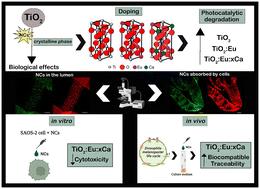当前位置:
X-MOL 学术
›
Environ. Sci.: Nano
›
论文详情
Our official English website, www.x-mol.net, welcomes your
feedback! (Note: you will need to create a separate account there.)
Europium and calcium-co-doped TiO2 nanocrystals: tuning the biocompatibility and luminescence traceability of Drosophila melanogaster
Environmental Science: Nano ( IF 5.8 ) Pub Date : 2024-10-21 , DOI: 10.1039/d4en00458b Jerusa Maria de Oliveira, Larissa Iolanda M. de Almeida, Francisco Rubens Alves dos Santos, João Paulo S. de Carvalho, Amanda I. dos S. Barbosa, Marcus Andrei R. F. da Costa, Vanessa Tomaz Maciel, Gabriela L. de Souza, Alysson N. Magalhães, Marcos V. Vermelho, Camilla Christian G. Moura, Felipe Berti Valer, Thiago Lopes Rocha, Sebastião William da Silva, Lucas Anhezini, Anielle Christine A. Silva
Environmental Science: Nano ( IF 5.8 ) Pub Date : 2024-10-21 , DOI: 10.1039/d4en00458b Jerusa Maria de Oliveira, Larissa Iolanda M. de Almeida, Francisco Rubens Alves dos Santos, João Paulo S. de Carvalho, Amanda I. dos S. Barbosa, Marcus Andrei R. F. da Costa, Vanessa Tomaz Maciel, Gabriela L. de Souza, Alysson N. Magalhães, Marcos V. Vermelho, Camilla Christian G. Moura, Felipe Berti Valer, Thiago Lopes Rocha, Sebastião William da Silva, Lucas Anhezini, Anielle Christine A. Silva

|
The incorporation of europium (Eu) ions improves the biocompatibility of TiO2 nanocrystals (NCs) and allows tracking by red luminescence. Calcium doping improves cellular compatibility while also facilitating better interaction with biological systems. Thus, in this work, were synthesized Eu and Ca co-doped TiO2 NCs and physical–chemical and biological properties were investigated. The physical–chemical properties were performed in order to analised the effects of the doping on the crystalline phase of TiO2 morphology, sized, zeta potential, hydrodynamic diameter, and photocatalytic properties. Biological assessments were conducted using in vitro assays with human osteosarcoma cells (SAOS-2) through cytotoxicity assays and in vivo assays with Drosophila melanogaster, where we evaluated the mortality rate during postembryonic development and the luminescence of nanomaterials in vivo. The physical–chemical properties confirmed with success the integration of Ca ions into the TiO2:Eu crystal (TiO2:Eu:xCa) NCs without additional phases. The co-doping of Ca led to a reduction of approximately 70% in photocatalytic activity. Moreover, co-doping with Ca was not cytotoxic to SAOS-2 cells. Our in vivo analysis showed no delays in postembryonic development and no larval or pupal lethality. The larval mortality rate and pupal formation rate were comparable to the control group when D. melanogaster was exposed to nanomaterials at concentrations of 1 mg mL−1 or lower. Luminescence of the NCs was detected in confocal microscopy images, indicating the presence of NCs in the larval brain and intestines. This luminescence was observed in TiO2:Eu:xCa NCs. These results showed that Ca doping improved the biocompatibility and enhanced the luminescence of these materials, making them traceable in biological tissues. Therefore, our research provides valuable insights into the tailored properties of TiO2 for potential applications in various fields of biomedicine.
中文翻译:

铕和钙共掺杂的 TiO2 纳米晶体:调节黑腹果蝇的生物相容性和发光溯源性
铕 (Eu) 离子的掺入提高了 TiO2 纳米晶体 (NC) 的生物相容性,并允许通过红光发光进行追踪。钙掺杂提高了细胞相容性,同时也促进了与生物系统的更好相互作用。因此,在这项工作中,合成了 Eu 和 Ca 共掺杂的 TiO2 NCs,并研究了物理化学和生物学性质。进行物理化学性质分析了掺杂对 TiO2 晶相形态、大小、zeta 电位、流体动力学直径和光催化性能的影响。通过细胞毒性测定使用人骨肉瘤细胞 (SAOS-2) 的体外测定和黑腹果蝇的体内测定进行生物学评估,其中我们评估了胚胎后发育过程中的死亡率和体内纳米材料的发光。物理化学性质成功地证实了 Ca 离子无需额外固定相即可整合到 TiO2:Eu 晶体 (TiO2:Eu:xCa) NC 中。Ca 的共掺杂导致光催化活性降低约 70%。此外,与 Ca 共掺杂对 SAOS-2 细胞没有细胞毒性。我们的体内分析显示胚胎后发育没有延迟,也没有幼虫或蛹的致死性。当黑腹果蝇暴露于浓度为 1 mg mL-1 或更低的纳米材料时,幼虫死亡率和蛹形成率与对照组相当。 在共聚焦显微镜图像中检测到 NCs 的发光,表明幼虫大脑和肠道中存在 NCs。在 TiO2:Eu:xCa NCs 中观察到这种发光。这些结果表明,Ca 掺杂提高了这些材料的生物相容性并增强了发光,使其在生物组织中具有可追溯性。因此,我们的研究为 TiO2 的定制特性提供了有价值的见解,可用于生物医学各个领域的潜在应用。
更新日期:2024-10-21
中文翻译:

铕和钙共掺杂的 TiO2 纳米晶体:调节黑腹果蝇的生物相容性和发光溯源性
铕 (Eu) 离子的掺入提高了 TiO2 纳米晶体 (NC) 的生物相容性,并允许通过红光发光进行追踪。钙掺杂提高了细胞相容性,同时也促进了与生物系统的更好相互作用。因此,在这项工作中,合成了 Eu 和 Ca 共掺杂的 TiO2 NCs,并研究了物理化学和生物学性质。进行物理化学性质分析了掺杂对 TiO2 晶相形态、大小、zeta 电位、流体动力学直径和光催化性能的影响。通过细胞毒性测定使用人骨肉瘤细胞 (SAOS-2) 的体外测定和黑腹果蝇的体内测定进行生物学评估,其中我们评估了胚胎后发育过程中的死亡率和体内纳米材料的发光。物理化学性质成功地证实了 Ca 离子无需额外固定相即可整合到 TiO2:Eu 晶体 (TiO2:Eu:xCa) NC 中。Ca 的共掺杂导致光催化活性降低约 70%。此外,与 Ca 共掺杂对 SAOS-2 细胞没有细胞毒性。我们的体内分析显示胚胎后发育没有延迟,也没有幼虫或蛹的致死性。当黑腹果蝇暴露于浓度为 1 mg mL-1 或更低的纳米材料时,幼虫死亡率和蛹形成率与对照组相当。 在共聚焦显微镜图像中检测到 NCs 的发光,表明幼虫大脑和肠道中存在 NCs。在 TiO2:Eu:xCa NCs 中观察到这种发光。这些结果表明,Ca 掺杂提高了这些材料的生物相容性并增强了发光,使其在生物组织中具有可追溯性。因此,我们的研究为 TiO2 的定制特性提供了有价值的见解,可用于生物医学各个领域的潜在应用。






























 京公网安备 11010802027423号
京公网安备 11010802027423号